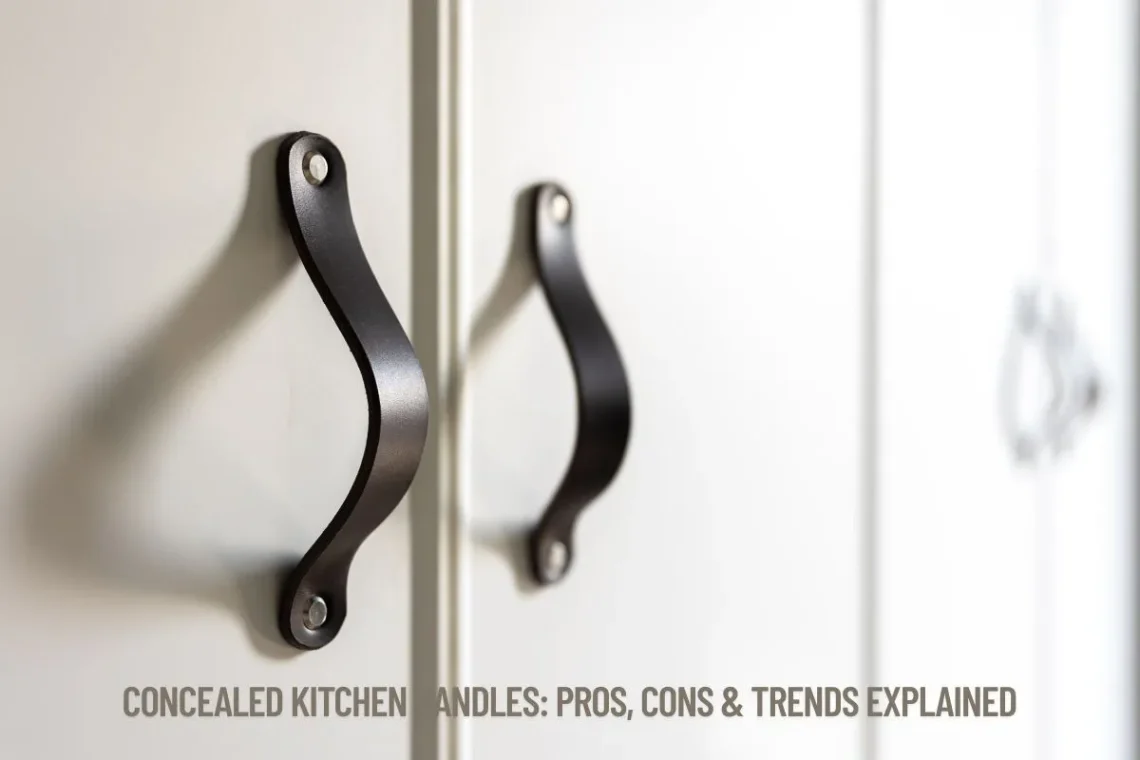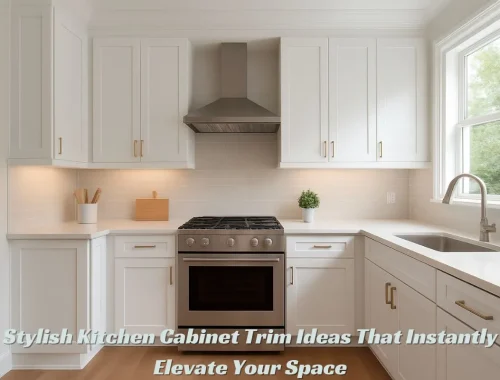
Concealed Kitchen Handles: Pros, Cons & Trends Explained
When it comes to designing or remodeling a kitchen, one detail that can make a big impact is the style of the cabinet handles—or whether you use handles at all. Concealed kitchen handles, also known as handleless kitchens or integrated handles, are becoming a popular choice for their sleek, modern look. In this article, we will explore the pros and cons of concealed kitchen handles, the latest trends, and how they compare in cost and function to traditional handles. I’ll also share some personal stories and useful tips along the way so the info feels friendly and practical.
Table of Contents
ToggleWhat Are Concealed Kitchen Handles?
Concealed kitchen handles are a design where the cabinet doors and drawers don’t have a visible handle on the surface. Instead, the handles are hidden in grooves, recessed sections, or behind the edges of panels, allowing you to open the cabinets without knobs or pulls sticking out. The result is a very clean and smooth look that blends beautifully with modern and minimalist kitchens.
Pros of Concealed Kitchen Handles
1. Sleek and Modern Aesthetic
Concealed handles give kitchens a seamless, contemporary feel. Without protruding handles, the cabinetry looks smooth and uninterrupted, which is popular in modern home design. I remember when I first installed concealed handles in my kitchen renovation; the whole space felt so much more open and tidy.
2. Easy to Clean
Without knobs or pulls sticking out, cleaning is a breeze. There are fewer spots for dust, grease, or food particles to gather. This was a lifesaver during holiday cooking chaos at my home—cleaning glossy, handleless cabinets was faster than I expected.
3. Safety
No handles means no bumps or snags, which is great if you have small children running around. No more accidental bruises on hip bones from poking into a handle!
4. Space Efficient
For compact kitchens or tight spaces, concealed handles prevent handles from clashing or getting caught on clothing or other objects. It can even help open up floor space when cabinetry aligns perfectly.
5. Versatility in Materials and Styles
Concealed handles go well with a variety of materials like wood, laminate, or painted surfaces because they don’t interrupt the visual flow of the cabinetry.
Cons of Concealed Kitchen Handles
1. Cost
Concealed handle designs can be more expensive than traditional cabinetry with visible handles. The additional complexity in manufacturing recessed grooves or special profiles often adds cost. When I upgraded to handleless cabinets, the price tag surprised me a bit, but I felt it was worth the style.
2. Durability and Wear
Since you typically grip the edges or grooves to open drawers and doors, these areas can wear faster due to frequent contact. Grooves can accumulate dirt and require cleaning inside the recesses.
3. Fingerprints and Marks
Glossy or matte door fronts can show fingerprints or smudges more visibly when there are no handles to distract from them. Regular cleaning is necessary to keep that pristine look.
4. Accessibility
People with mobility issues or arthritis may find it harder to grip and pull open handleless cabinets, especially if the groove is narrow or the doors are heavy. This is one reason designing for all users is important.
5. Installation Limits
Not all kitchen designs or cabinet types can accommodate concealed handles easily. Retrofitting old cabinets can be tricky or expensive.
What Are the Disadvantages of Handleless Kitchens?
Handleless kitchens fall under the broader umbrella of concealed handle kitchens. Here are some specific disadvantages to consider:
-
Requires Custom Design: Handleless kitchens often need custom-made cabinets or special profiles, which can add time and cost.
-
Maintenance Challenges: Recessed areas can trap dust and crumbs, requiring regular detailing.
-
Potential for Reduced Grip: The mechanism to open cabinets relies heavily on grip strength on edges or grooves, which might frustrate some users.
-
Less Variety in Style: If you want ornate or vintage styles, handleless kitchens might not match well.
What Is Trending for Kitchen Cabinet Handles?
While handleless kitchens have become popular, especially in modern and minimalist designs, there are other trends shaping kitchen hardware:
-
Slimline and Minimalist Handles: Thin bars or flat pulls that barely protrude are gaining popularity for a subtle look.
-
Matte Black and Brushed Metals: Handles in matte black, brass, or brushed nickel finishes are trendy, adding contrast and elegance.
-
Mixed Materials: Combining wood, metal, or leather handles creates unique textures and visual interest.
-
Integrated Finger Pulls: Some kitchens feature very subtle finger pulls that are part of the cabinet edge, blending the line between handleless and handled.
-
Industrial and Vintage Styles: For traditional or rustic kitchens, chunky iron or brass handles are back in style.
Which Handles Are Best for a Kitchen?
Choosing the best handles depends on many factors—kitchen style, usage, budget, and personal preference.
-
For modern and minimalist kitchens, concealed handles or slimline pulls work best to keep the look clean.
-
For traditional or rustic kitchens, ornate knobs or classic bar handles fit the vibe.
-
For accessibility, larger, easy-to-grip handles or D-shaped pulls are kinder to hands.
-
For everyday practicality, think about materials that are durable and easy to clean—brushed or matte finishes hide fingerprints better than shiny metals.
What Are the Disadvantages of Handles?
While handles are standard in kitchens and offer many benefits, they also have drawbacks:
-
Can Catch on Clothing or Bags: Especially if bulky or sharp-edged.
-
Require Cleaning: Grease and dirt collect around handles.
-
May Interrupt Design Flow: Some handles can break the smooth line of cabinetry.
-
Can Loosen or Break: Handles may need tightening or replacement over time.
Cost Comparison: Concealed Handles vs. Traditional Handles
| Feature | Concealed Handles | Traditional Handles |
|---|---|---|
| Initial Cost | Higher due to custom profiles and design | Usually lower, many options available |
| Maintenance | Regular cleaning of grooves needed | Clean around handles regularly |
| Installation | Often custom, more labor-intensive | Easier installation, ready-made options |
| Longevity | Can cause edge wear on cabinets | Handles may loosen or break over time |
| Style Impact | Sleek, modern look | Variety of styles and finishes |
Anecdotes
I remember visiting a friend who had just remodeled their kitchen with handleless cabinets. At first, I tripped over the idea of no knobs, but after a few days, I loved how smooth and neat it all felt. The kitchen looked huge and clutter-free!
On the flip side, I once helped a relative install handleless drawers and learned just how important it is to plan the grooves carefully. Some were too narrow and got stuck with dirty fingers. We cleaned and adjusted them, and it worked beautifully after that.
Final Thoughts
Concealed kitchen handles offer a fresh, modern take on cabinetry that makes kitchens look sleek and clutter-free. They bring advantages in aesthetics and safety but also come with some trade-offs in cost, maintenance, and accessibility. Whether you choose concealed handles, traditional hardware, or something in between, your kitchen should match both your style and lifestyle.
If you’re considering a kitchen upgrade, think about how you use your space every day and weigh the pros and cons outlined here. Remember, a beautiful kitchen is one that feels good to use!
Happy kitchen designing! If you want more help with picking materials or installation tips, just ask!
You May Also Like

ZZ Plant (Zanzibar Gem) Profile: The Unstoppable Houseplant
July 29, 2025
Stylish Kitchen Cabinet Trim Ideas That Instantly Elevate Your Space
October 12, 2025

